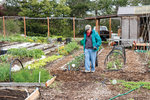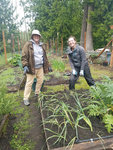

In a time when many are without jobs and might be struggling to pay the bills, Jefferson County residents don’t have to worry about affording fresh produce.
That’s because all across the county, volunteers are getting their hands dirty to help their fellow community members stay healthy.
There are eight food bank gardens in the county, where groups of these volunteers spend hours planting, weeding and watering fruit and vegetables such as lettuce, kale, green beans, peas, tomatoes, rhubarb, raspberries, herbs, potatoes, onions, garlic and more.
Then, they harvest the fruits of their labor, wash, bag and deliver them to the Port Townsend, Tri-Area, Quilcene and Brinnon food banks where they are distributed to food bank customers.
“I used the food banks for two years in this community because there aren’t a whole lot of high-paying jobs here,” said Rachel Smith, the volunteer coordinator for Food Bank Farm and Gardens. “It’s an incredible thing to be able to go into a food bank and have fresh produce.”
The original food bank garden, located at the Port Townsend Mountain View Commons, started in the spring of 2012 and was assisted by a grant from the Jefferson County Master Gardeners Foundation and a donation from the Jefferson County Food Bank Association to construct a hoop house for tomato production.
That year, volunteer gardeners harvested and delivered 800 pounds of fresh produce to the food bank. The next year, the garden expanded to three community gardens in Port Townsend, including one at Port Townsend High School, where students grow food.
Fast forward to today and five more community gardens have popped up in the Tri-Area. In addition, several farms, such as Sunfield Farm and Finnriver Farm, have dedicated space to growing food for the food banks.
The food bank gardens donated at least 6,000 pounds of fresh produce to the Port Townsend, Tri-Area, Brinnon and Quilcene food banks in 2019.
“What I like about our food banks is that they’re for everyone,” said Jo Yount, supervisor at the Quimper Grange garden. “If you come in and say you need food, you get food.”
Yount works with about 15 regular volunteers to design a space that is regenerative, healthy and produces lots of food for the community.
She is always looking for creative ways to grow food, whether by trellising the raspberries so they get more sunlight and are easier to pick, or by growing potatoes in cloth bags so they take up less space and are easier to harvest.
“We try to find things we know people are missing,” she said.
In the Quimper Grange’s hoop house, they grow tomatoes, lettuce and spinach. They provide salad and stir-fry mixes for the food bank so customers can get a little bit of everything.
“We try to get the most product out of the space we’ve got,” Yount said.
Last year, they delivered 3,000 pounds of food to the Port Townsend Food Bank.
But beyond providing for the community, the volunteers at the various gardens get the chance to learn about growing food.
“It gets people involved in the community together, caring for each other,” Smith said. “Especially right now, it’s super important. It teaches people how to garden, too.”
In the future, Food Bank Farm and Gardens organizers hope to grow their production even more.
They currently have a GoFundMe page to purchase freeze dryers to reduce food waste.
Smith hopes to engage younger people, including kids who are not in school right now, or young adults who have temporarily lost their jobs due to the coronavirus, to start volunteering in the gardens.
“It’s an opportunity to get outside and be involved,” she said.
For those interested in volunteering, email foodbankfarmandgardensjc@gmail.com.